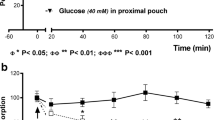Abstract
PURPOSE: Barrier properties of an isolated colon loop and the remnant colon in continuity with the gastrointestinal tract after colostomy were studied in the rat. METHODS: The in vivo absorption after colonic loop administration of the marker fluorescein sodium was measured as the urinary recovery. The in vitro permeability was measured in Ussing diffusion chambers as the transmucosal passage of [14C]mannitol and of human serum albumin in the isolated and the nonexcluded colonic segments and was compared with the corresponding colonic regions from sham-operated rats at 1 to 14 days after operation. RESULTS: Body weight gain of the rats decreased and diarrhea appeared from day 2 after colostomy. Histologic examination showed mucosal atrophy with decreased villus height in the isolated colonic loop and an increased villus height in the nonexcluded colon segment. Absorption of fluorescein sodium in the isolated loop was increased at 8 and 14 days. Moreover, permeability in the isolated loop was increased for both mannitol and human serum albumin from four days after colostomy compared with the corresponding colonic segments after the sham operation, whereas a decrease in the passage of mannitol was noted in the nonexcluded colon. CONCLUSIONS: Experimentally performed colostomy diversion in the rat induced alterations of the barrier function in both the isolated colonic loop and the nonexcluded colon in continuity with the fecal stream.
Similar content being viewed by others
References
Fallis LS. Transverse colostomy. Surgery 1946;20:249–56.
Cromar CD. The evolution of colostomy, part VIII. Complications of colostomy. Dis Colon Rectum 1968;11:430–8.
Rombeau JL, Wilk PJ, Turnbull RB Jr, Fazio VW. Total fecal diversion by the temporary skin-level loop transverse colostomy. Dis Colon Rectum 1978;21:223–6.
Brown JY. Value of complete physiologic rest of large bowel in ulcerative and obstructive lesions. Surg Gynecol Obstet 1913;16:610–3.
Turnbull RB Jr, Hawk WA, Weakly FL. Surgical treatment of toxic megacolon: ileostomy and colostomy to prepare patients for colectomy. Am J Surg 1971;122:325–31.
Kronborg O. Treatment of perforated sigmoid diverticulitis: a prospective randomized trial. Br J Surg 1993;80:505–7.
Morris DM, Rayburn D. Loop colostomies are totally diverting in adults. Am J Surg 1991;161:668–71.
Orsay CP, Kim DO, Pearl RK, Abcarian H. Diversion colitis in patients scheduled for colostomy closure. Dis Colon Rectum 1993;36:366–7.
Harig JM, Soergel KH, Komorowski RA, Wood CM. Treatment of diversion colitis with short-chain-fatty acid irrigation. N Engl J Med 1989;320:23–8.
Fabia R, Willén R, Ar'Rajab A, Andersson R, Ahrén B, Bengmark S. Acetic acid-induced colitis in the rats: a reproducible experimental model for acute ulcerative colitis. Eur Surg Res 1992;24:211–25.
Fabia R, Ar'Rajab A, Willén R,et al. Effects of phosphatidylcholine and phosphatidylinositol on acetic acidinduced colitis in the rat. Digestion 1992;53:35–44.
Fabia R, Ar'Rajab A, Johansson M-L,et al. The effect of exogenous administration of Lactobacillus reuteri R2LC and oat fiber on acetic acid-induced colitis in the rat. Scand J Gastroenterol 1993;28:155–62.
Otamiri T, Lindahl M, Tagesson C. Phospholipase A2 inhibition prevents mucosal damage associated with small intestinal ischaemia in rats. Gut 1988;29:489–94.
Wang Q, Pantzar N, Jeppsson B, Weström B, Karlsson B. Increased intestinal marker absorption due to regional permeability changes and decreased intestinal transit during sepsis in the rat. Scand J Gastroenterol 1994;29:1001–8.
Lowry OH, Rosebrough N, Farr A, Randall RJ. Protein measurement with the Folin phenol reagent. J Biol Chem 1951;193:265–75.
Grass GM, Sweetana SA.In vitro measurements of gastrointestinal tissue permeability using a new diffusion cell. Pharm Res 1988;5:372–6.
Pantzar N, Weström BR, Luts A, Lundin S. Regional small-intestinal permeabilityin vitro to different-sized dextrans and proteins in the rat. Scand J Gastroenterol 1993;28:205–11.
Laurell CB. Electrophoretic and electroimmunochemical analysis of protein. Scand J Clin Lab Invest 1972;29:S21.
Travis S, Menzies L. Intestinal permeability: functional assessment and significance. Clin Sci (Colch) 1992;82:471–88.
Doolas A, Caldwell RG, Roseman DL, de Peyster FA. Colon, appendix, rectum, and anus. In: McCredie JA, ed. Basic surgery. New York: Macmillan, 1977:372–88.
Hollander D. The intestinal permeability barrier: a hypothesis as to its regulation and involvement in Crohn's disease. Scand J Gastroenterol 1992;27:721–6.
Gumbiner B. Structure, biochemistry, and assembly of epithelial tight-junctions. Am J Physiol 1987;253:C2749–58.
Stevenson BR, Anderson JM, Bullivant S. The epithelial tight junction: structure, function and preliminary biochemical characterization. Mol Cell Biochem 1988;83:129–45.
Fink MP. Gastrointestinal mucosal injury in experimental models of shock, trauma, and sepsis. Crit Care Med 1991;19:627–41.
Senagore AJ, MacKeigan JM, Scheider M, Ebrom JS. Short-chain fatty acid enemas: a cost-effective alternative in the treatment of nonspecific proctosigmoiditis. Dis Colon Rectum 1992;35:923–7.
Krugliak P, Hollander D, Schlaepfer CC, Nguyen H, Ma TY. Mechanisms and sites of mannitol permeability of small and large intestine in the rat. Dig Dis Sci 1994;39:796–801.
Author information
Authors and Affiliations
About this article
Cite this article
Wang, Q., Wang, Xd., Jeppsson, B. et al. Influence of colostomy onin vivo andin vitro permeability of the rat colon. Dis Colon Rectum 39, 663–670 (1996). https://doi.org/10.1007/BF02056947
Issue Date:
DOI: https://doi.org/10.1007/BF02056947




